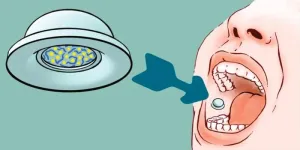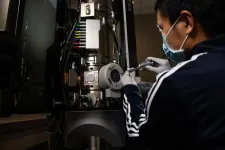(Press-News.org) Many of today’s medications belong to groups of relatively large molecules such as peptides. They are used to treat a wide range of diseases, including diabetes, obesity and prostate cancer. Unfortunately, taking these medications in tablet form is out of the question in most cases because they would break down in the digestive tract or remain too large to reach the bloodstream. Consequently, the patient’s only option is to receive their medication via injection.
A group of researchers at ETH Zurich have developed a suction cup capable of delivering medications comprising large molecules like peptides to the bloodstream via the mucosal lining of the cheek. The group is led by David Klein Cerrejon and Nevena Paunović, both of whom work at the Chair of Drug Formulation & Delivery headed by Jean-Christophe Leroux.
“It’s an entirely new method of delivering medications that could spare millions of people the fear and pain associated with injections,” says Paunović, who has received one of ETH Zurich’s coveted Pioneer Fellowships. Her aim is to bring the suction cup to market through the start-up Transire Bio.
Breaking through the cheek’s mucosal lining
The mucosal lining of the cheek isn’t particularly suitable for delivering medication to the bloodstream. Its dense tissue has so far presented a major obstacle, especially for large molecules like peptides. But the ETH researchers are now about to change this with their suction cup.
Patients press the suction cup – which measures around ten millimetres in diameter and six millimetres in height – onto the lining of their cheek with two fingers. This produces a vacuum that stretches the lining, making it more permeable to the drug contained within the cup’s dome-shaped hollow. But that alone isn’t enough for the drug to reach the blood vessels.
The researchers have thus supplemented the drug with an endogenous agent that fluidises the cell membranes, allowing the drug to penetrate to the deeper layers of tissue. Patients are advised to keep the suction cup on the inside of their cheek for a few minutes. That’s enough time for the drug to dissolve in saliva and enter their bloodstream directly via the now permeable mucosal lining.
Compared to the few oral formulations of peptides on the market, the suction cup developed by the ETH researchers supports the delivery of a wide range of medications without the need for any major technological adjustments.
From peppercorn to suction cup
The original idea for the suction cup came from Zhi Luo, a former postdoc under ETH Professor Leroux and now a professor himself working in China. At dinner with friends, he suddenly noticed he had half a peppercorn stuck to the inside of his oral cavity. Although uncomfortable, this experience gave him the idea of how to keep drugs in place on slippery surfaces. But before the team could turn the idea into a working prototype, they had a few problems to solve.
The biggest challenge was to identify the right shape of the suction cup. “We had to find out what geometry and how much of a vacuum were required to hold the suction cup in place on the mucosal lining of the cheek and to stretch it sufficiently without causing any damage,” Klein Cerrejon says. In addition to producing several prototypes, which the researchers designed and 3D printed themselves, this called for numerous tests using the mucosal lining of a pig’s cheek.
To find the right penetration-promoting agent, the researchers tested a broad range of substances of varying concentrations and under a microscope evaluated how the different mixtures penetrated the tissue. “Since the suction cup is a completely new delivery system, we had to experiment extensively before finding the right substance. It turned out that natural, endogenous substances are extremely well suited for this task,” Klein Cerrejon says.
Tests on dogs and humans
The researchers then moved on to testing their suction cup and the penetration-promoting agent in authorised trials on dogs, because dogs and humans have very similar mucosal lining in their cheeks. No dogs were harmed by the testing. The researchers were pleased with the results: “We could see from the blood samples that the suction cup efficiently delivered medications to the dogs’ bloodstreams,” Klein Cerrejon says.
So far, the team has also tested the empty suction cup on 40 people. Not only did the suction cup remain attached for 30 minutes but also received positive feedback from the people testing it. Most of the volunteers said that they would by far prefer the new delivery system over an injection.
On the way to market entry
Paunović – who completed her doctorate under Leroux – is a trained pharmacist and worked at a major drug company. She will lead the project as a Pioneer Fellow. “We have a prototype and have already patented the technology. Our next step is to manufacture the suction cup in a way that meets current pharmaceutical regulations,” she says.
The researchers will have to carry out further tests with this new delivery system in preparation for conducting a clinical trial on healthy volunteers. There are also several regulatory hurdles to clear before the suction cup hits the market. For this, the researchers need strong partners and sufficient funding. Since the peptide market is worth billions to the pharmaceutical industry, several companies have already voiced an interest.
END
How a suction cup delivers medications to the bloodstream
2023-09-28
ELSE PRESS RELEASES FROM THIS DATE:
Scientists observe the influence of gravity on antimatter for the first time
2023-09-28
Scientists have demonstrated the existence of gravity between antimatter and Earth, reaffirming Albert Einstein’s General Theory of Relativity.
It is thought that Isaac Newton's historic work on gravity was inspired by watching an apple fall to Earth from a tree. But for decades, scientists have wondered what would happen to an “anti-apple” made of antimatter - would it fall in the same way if it existed?
Until now, the question has left scientists with an incomplete picture of the Universe's gravitating content.
In a paper published today in Nature, the ALPHA collaboration at CERN’s Antimatter Factory, which ...
NYU Tandon School of Engineering Researchers unveil tool to help developers create augmented reality task assistants
2023-09-28
Augmented reality (AR) technology has long fascinated both the scientific community and the general public, remaining a staple of modern science fiction for decades.
In the pursuit of advanced AR assistants – ones that can guide people through intricate surgeries or everyday food preparation, for example – a research team from NYU Tandon School of Engineering has introduced Augmented Reality Guidance and User-Modeling System, or ARGUS.
An interactive visual analytics tool, ARGUS is engineered to support the development of intelligent AR assistants that can run on devices like Microsoft ...
Specific interneurons are important in aging-associated cognitive decline, study finds
2023-09-28
Normal aging is usually associated with a decline in memory, although it is unclear what factors play a role. In a new study, researchers studied specific interneurons, which serve as communication centers that connect other neurons, in the regions of the brain that are important for learning and memory.
Increasing age places people at risk, whether it is because of a normal decrease in cognitive ability or due to postoperative cognitive disorders. In the latter, the deficits can persist for many months after surgery especially when the patients are older than 60. Unfortunately, the ...
New study provides evidence for more effective brain-based treatment of chronic back pain
2023-09-28
A new study in JAMA Network Open may provide key answers to how to help people experiencing chronic back pain.
The study, published today, examined the critical connection between the brain and pain for treating chronic pain. Specifically, they looked at the importance of pain attributions, which are people’s beliefs about the underlying causes of their pain, to reduce chronic back pain severity.
“Millions of people are experiencing chronic pain and many haven’t found ways to help with the pain, making it clear that something is missing in the way we’re diagnosing and treating people,” said the ...
A new twist on rechargeable battery performance
2023-09-28
RICHLAND, Wash.—For decades, researchers have assumed that the inevitable filmy buildup on electrodes inside rechargeable batteries is the driver of performance loss. Now, we know that view is backward.
The buildup of mossy or tree-like structured lithium metal deposits on battery electrodes is not the root cause of performance loss, but rather a side effect. The first direct measurement of the electrical properties at the boundary between the solid electrode and the liquid electrolyte inside a rechargeable battery is reported today in Nature Energy.
The study, led by a research team at the Department of Energy’s Pacific Northwest National Laboratory, shows that the so-called ...
Pharmacist-led intervention can improve medication adherence among Latinos with type 2 diabetes
2023-09-28
UCLA-led research suggests that diabetes control can significantly improve for Latinos when a pharmacist implements an intervention that addresses these patients’ barriers to medication adherence.
In this pharmacist-led intervention, pharmacists reviewed the patients’ lab results, vital signs, and barriers to adherence. They then used this information to design a personally-tailored intervention to boost medication adherence and optimize the treatment regimen.
The study is the first to evaluate a collaboration between pharmacist and physicians aimed at improving diabetes care in a large healthcare system among Latino patients, said study lead Dr. Kimberly Narain, ...
Decoding the complexity of Alzheimer’s disease
2023-09-28
CAMBRIDGE, MA -- Alzheimer’s disease affects more than 6 million people in the United States, and there are very few FDA-approved treatments that can slow the progression of the disease.
In hopes of discovering new targets for potential Alzheimer’s treatments, MIT researchers have performed the broadest analysis yet of the genomic, epigenomic, and transcriptomic changes that occur in every cell type in the brains of Alzheimer’s patients.
Using more than 2 million cells from more than 400 postmortem brain samples, the researchers analyzed how gene expression is disrupted as Alzheimer’s progresses. They also tracked changes in ...
Accelerating sustainable semiconductors with ‘multielement ink’
2023-09-28
Key takeaways:
Scientists have developed “multielement ink” – the first “high-entropy” semiconductor that can be processed at low-temperature or room temperature.
Multielement ink could enable cost-effective and energy-efficient semiconductor manufacturing.
The new semiconducting material could accelerate the sustainable production of next-gen microelectronics, photovoltaics, solid state lighting, and display devices.
Semiconductors are the heart of almost every ...
Researchers create first-ever map of a single animal’s early visual system
2023-09-28
Neuroscientists at the Flatiron Institute in New York City and their colleagues have made a big breakthrough using one of the world’s smallest brains.
Using an ion beam, an electron microscope and a lot of patience, the neuroscientists mapped out the entire early visual system — from the eyes that take in light to the neurons processing the information — for a parasitic wasp smaller than a grain of table salt. The feat marks the first time scientists have fully reconstructed such a system at the synaptic level from a single specimen of any animal species, the neuroscientists report ...
Study reveals more depression in communities where people rarely left home during the COVID-19 pandemic
2023-09-28
Key Takeaways
In a survey-based study of US adults, those living in communities in which most people seldom left home at certain times during the COVID-19 pandemic were more likely to report symptoms of depression
The link remained strong even after considering COVID-19 activity, weather, and county-level economics
Accounting for state-level pandemic restrictions only modestly attenuated the association
BOSTON – Higher levels of depressive symptoms have been reported during the COVID-19 pandemic compared with other times in history, and as much as three times higher than prior to the ...



